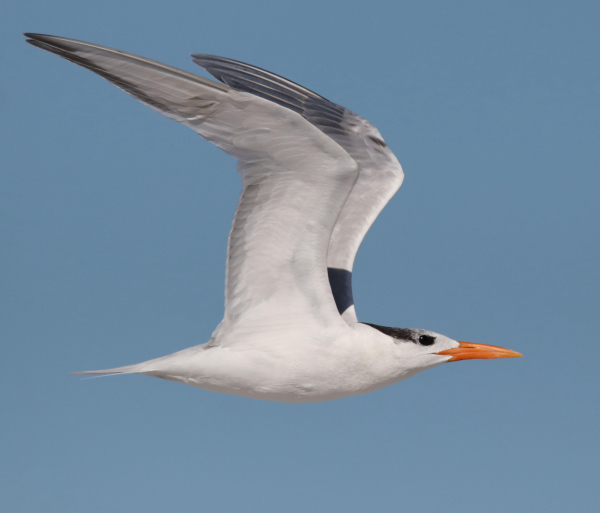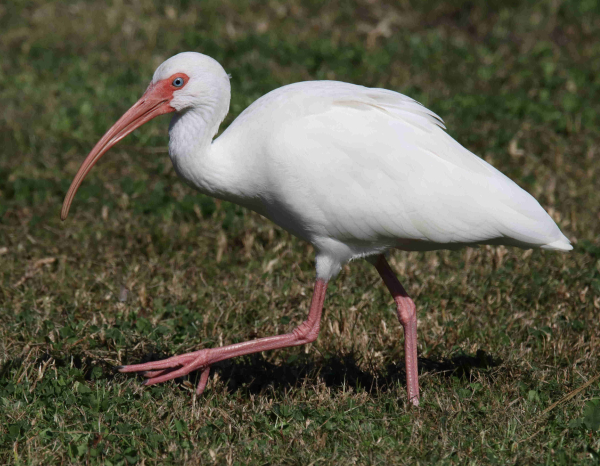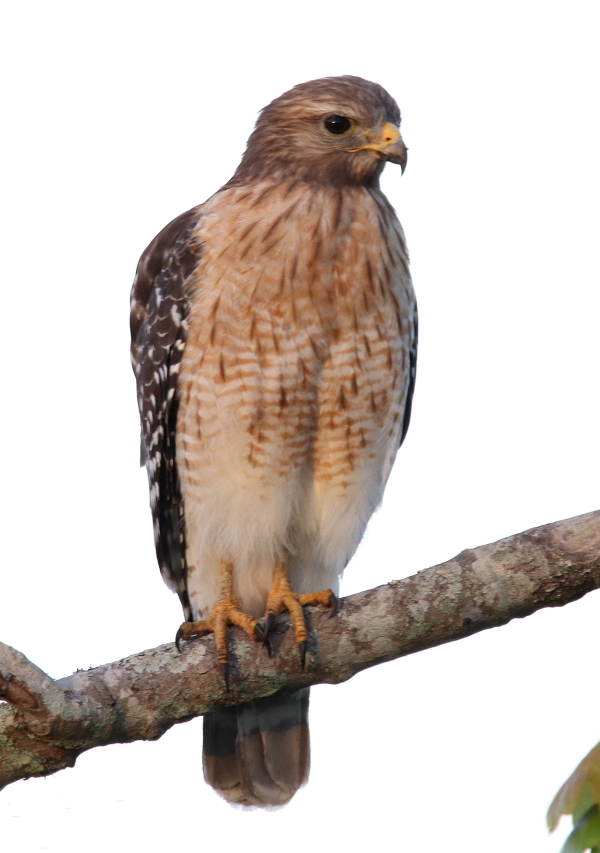
Among the varied birds that make ‘passive’ appearances overhead are Elegant Terns, so streamlined and elegant looking in flight.

White Ibis are a fairly common “yard bird” in some Gulf Coast areas, foraging through a neighborhood, lawn by lawn.

After many days of trying, Monday evening a Red-shouldered Hawk provided some low-light sunset photos as it hunted from several perches along the edge of the Konrad’s yard.
|
While I am spending time in the suburbs of Tampa, Florida, I’m reminded of the importance of landscaping; providing a variety of bird habitats – micro-habitats perhaps – to attract birds to our yards. My hosts for 10 days are my brother and sister, who don’t feed birds, but the abundance and variety of birds that visit their yard is very impressive, and it’s obviously due to the varied habitats in and surrounding their yard. Anchored by the cover of a live oak and palmetto edge where grass, ferns, and flowering plants fill in, and bordered by short lawn and long natural grass, with a small impoundment lake – it’s a magnet for birds.
Feeding birds is often the primary way we attract birds to our yards, it has been interesting to see the effects of a feederless backyard habitat. Among the many birds that forage in the habitat mix are loose flocks of wintering Yellow-rumped Warblers and Palm Warblers, plus American Robins, Northern Cardinals, Blue Jays, Mourning Doves, and Downy Woodpeckers. Along the edge of the trees where the grass is shorter, a Willow Flycatcher often perches to hunt for small insects, moving into the open lawn area to perch and hunt too, as do Northern Mockingbirds. The wintering warblers also forage in the long grass area and the tree edge where those habitat features meet, and one time I sighted a few Prairie Warblers in the live oaks that reacted to my “pishing” calls to move closer. A number of Red-shouldered Hawks also make regular territorial flights accompanied by loud calls above the trees and open areas.
The birds noted above are the species I would expect in a suburban Sunbelt area in the southeast States, but there is another level to the birdlife that abounds outside Jim and Rose’s windows and patio. The body of water attracts a variety of birds to the neighborhood, including White Ibis, Glossy Ibis, an occasional Great Blue Heron, Little Blue Heron, Snowy Egret, and Cattle Egrets; plus small groups of White Pelicans, an Anhinga, a Double-crested Cormorant or 2, and irregular flyovers by gulls that never land – Laughing Gulls and Ring-billed Gulls. Likewise, the occasional soaring Turkey Vulture or Black Vulture don’t stop, but they are fun to watch gliding by so effortlessly.
Favorite fly-bys are the occasional Elegant Tern that slice the blue sky in a truly elegant way; they appear so sleek and streamlined, made for swift flight. Perhaps the most dramatic of the backyard visitors are the pairs of Sandhill Cranes that fly by calling, and sometimes a pair will walk into the yard in search of natural food, as do White Ibis occasionally – species that are impressive for me to witness in a backyard and neighborhood setting! And this scenario is not limited to the Konrads’ neighborhood.
It's really impressive to see how birds have adapted to living in many areas of Tampa, and many other regions of Florida – and beyond. Part of the equation is that people and housing developments are providing habitat within neighborhoods – landscaping that favors a variety of birds. Plus, in most areas of Florida and certainly in the Tampa region, there is an abundance of water catchment ponds that favor waterbirds, wading birds, shorebirds, waterfowl, and other wildlife as they hold water in these basins that help protect surrounding homes during high rainwater periods. You probably know the situation, and there is a pretty big habitat give and take involved for birds and other wildlife, but from a backyard perspective, it’s pretty impressive.
In another neighborhood of Tampa, I encountered a large and concentrated flock of Yellow-rumped Warblers that rivaled the best spring fallout I’ve experienced. The active flock covered the entire neighborhood – in the trees, the bushes, on the lawns, and in the streets, and including my niece and nephew’s yard and all their neighbors’ yards. Krista and Casey live a hundred yards or so from a large lake, and their most notable visitors might be the Black-bellied Whistling Ducks that a neighbor feeds daily, and they have all kinds of flyovers including Ospreys, White Pelicans, Glossy Ibis, White Ibis, Red-shouldered Hawks, and more. Their oldest son, who will turn 3 tomorrow (Thursday), is a Northern Mockingbird fan, and one day Blake and his Mom witnessed an adult Bald Eagle perched on their back fence, not many feet from their lanai – they both were duly impressed and excited.
These are just 2 interesting backyard birding stories in which family members live in close proximity with bird-rich areas, and without operating a feeding station, they appreciate the birds that they observe through passively attracting birds to their contributions of mixed habitat that continues through their neighborhoods. Certainly, it’s kind of impossible to stock feeders for egrets, cranes, ibis, pelicans, hawks, and others that are regularly seen in areas of greater Tampa. My own home habitat attracts a variety of exciting “passive” sightings that occasionally include a Great Horned Owl, Cooper’s Hawk, Ruby-crowned Kinglets, Brown Creepers, Mourning Warblers, Brown Thrashers, and many others – and I hope you get great passive birds too. Just the same, if you provide a varied bird feeding program through the seasons – like me – keep up your stalwart efforts, especially considering that you and the birds benefit from your food and water, as well as your passive habitat – Good Luck.
Post Script: One of the birds I hope to get quality photos of in the sunshine state is a Red-shouldered Hawk, a species I see daily above the Florida Konrads’ yard as a number of these raptors fly overhead calling from time to time. I haven’t had much luck trying to photograph them, but Sunday evening as I walked to my car in the front yard, I was taken aback when I saw a Red-shouldered Hawk fly up from the ground 40 feet away and land in a tree 25 feet away. When Rose came outside, the hawk had moved to a 3 foot high perch, then dropped to the ground as though making a hunting strike on a lizard, but returning to the low perch empty-footed. How I wished I could photograph the hawk, but the lighting had dropped to near-dark under an evening cloud cover. Nonetheless, it was a memorable sighting, and it might lead to a photo op should the hawk return.
PPS – 24 hours later, a Red-shouldered Hawk, possibly the same one, was on the hunt from tree branches and on the ground, permitting me to take a series of low-light photos as the sun was setting; and a few turned out pretty well – I share a favorite photo with you here.
Share your backyard birding experiences and photos with The Birding Wire at editorstbw2@gmail.com
Article and photos by Paul Konrad